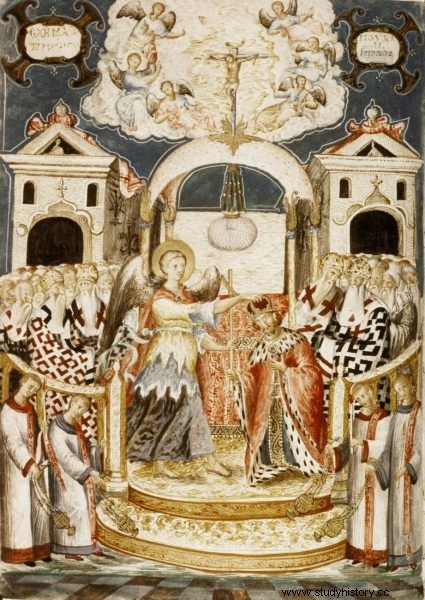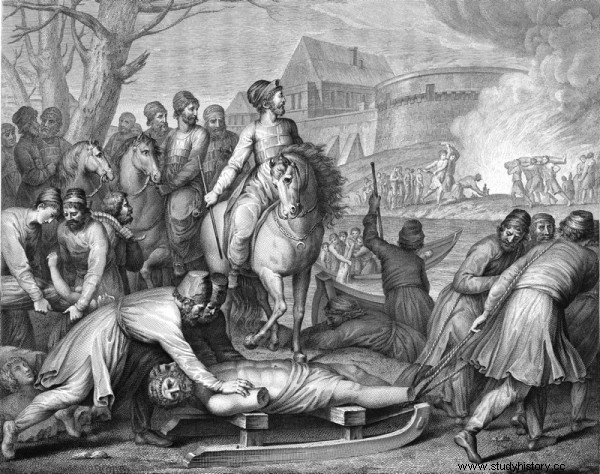There are many theories that move Poland's baptism even a hundred years back. However, many more sources speak for the opposite version of events. Is it possible that Mieszko died as a pagan, and only his son converted to Christianity thanks to a Czech missionary?
The famous chronicles of Gall Anonim and Wincenty Kadłubek are of little value in relation to the Piast conversion. Gall was writing almost one hundred and fifty years after Dobrawa came to Greater Poland. In the case of Kadłubek, this time distance is even greater. What could the good bishop know about events from before two hundred and thirty years?
Only authors from the West wrote about the baptism of Poland. The account of Merseburg, the bishop of Merseburg, who hates the Piasts, is well known. However, few have heard of his colleague - the French chronicler Adémar from Chabannes. A pity, because he had some really strange things to say.
Adémar wrote his chronicle over a thousand kilometers from the Piast borders, but almost on a regular basis. In the thousandth year he was already a teenager, and it seems he started writing while Bolesław Chrobry was still alive. As a rule, he dealt with the history of the Franks, but in the margins of stories he also smuggled information that Christianity came to Poland ... only with Wojciech and that it was this saint who baptized Bolesław.

Was the first Christian ruler of Poland - who was not Mieszko I - baptized by St. Wojciech? Such revelations can be found in the French chronicle by Adémar of Chabannes (source:public domain).
A tool in the hands of satan?
Mistake? Misunderstanding? Case? If so, it would be a surprisingly frequent case, because there are more similar sources. As for early medieval conditions:an incredible amount. For example, a letter is known in which the Duchess of Lorraine Matylda calls Bolesław the "source" of Polish Christianity.
Even in the epitaph placed on the tomb of Brave (and written probably already around 1025) it was stated that ... he was born "of a pagan father." It's as if Mieszko was not baptized at all in 966.
Finally, we should also mention the legend about the life of Saint Adalbert. It was written around 1004 by Bruno of Kwerfurt. A great friend of Bolesław the Brave, a man who knew the Polish court well, and in the following years he was even an unofficial ambassador of the Piasts. In his text Mieszko - and Mieszko from the late years of his life! - he is a leader "tormenting Christians" and a tool in the hands of Satan . Only Bolesław is presented as a deeply religious ruler or even God's chosen one.
His own son doomed him to oblivion?
There are simply too many mentions of Brave as the first Polish Christian to be considered a mistake. It does not mean, however, that everything we learned at school about the baptism of Poland is a lie. We have hard evidence confirming the conversion of Mieszko I. He really joined the Church in the 60s.

Being a Christian ruler in medieval Europe opened many doors. Mieszko I belonged to this group, although some were very anxious to raise doubts about this fact (source:public domain).
Someone, however, was clearly very keen to wreak havoc. And by questioning Mieszko's historical merits and his status as a Christian, civilized ruler. One does not have to look far for the guilty ones. If history was manipulated by someone, it was Bolesław the Brave himself. The first Polish ruler aware of the importance of propaganda. And at the same time:a man with a deep and justified resentment towards his father.
At the end of his life, Mieszko placed his trust in his young German wife, Oder. It was to her and her sons that he intended to hand over power in the state. Meanwhile, Chrobry was sent to a distant province, because it is difficult to define the newly conquered Lesser Poland in any other way in relation to those years.
The old prince, however, overestimated the possibilities of his wife. Oda's regency lasted no more than three years. Bolesław won the civil war, united the state and chased his stepmother and brothers away. It did not stop there. He made sure that Oda was completely erased from history.

The article was inspired by, among others, the book by Dominik W. Rettinger, “Wiara i Tron. Saint Adalbert and the beginnings of Poland ”(WAM Publishing House 2016). Available at Znaku!
online bookstoreThere is no mention of her in the yearbooks, and according to later Polish chronicles, Mieszko had only one Czech wife. Information about Oda survived only in the notes of the German bishop Thietmar.
Perhaps the Piast ruler did not know the Roman punishment "damnatio memoriae" - sentencing to oblivion - but he acted deliberately and persistently. He is the first, but not the last. With regard to subsequent members of the dynasty, for example Bolesław the Wrymouth, we know more cases where traitors or enemies of the prince were unceremoniously crossed out of the years. Their lives were considered as null and void.
Baptism of Poland? None of these things
If Chrobry did this to his stepmother, it is no wonder that did not spare his father either. Significantly, the oldest Polish years do not even mention his death - the date is known only thanks to Thietmar and German obituaries. Above all, however, Bolesław made efforts to humiliate and ridicule Mieszko. It must be emphasized that his task was very easy.

The vision of Mieszko I as a fierce enemy of the old deities and a determined promoter of the Christian faith among the Polish people should be put among fairy tales (source:public domain).
He did not lie to the story, but only… colored it in his favor. In one basic point, the propaganda vision of baptism distributed by the court of Brave corresponded to the facts. In 966, Poland was not really baptized.
Christianity. Faith of a narrow elite
To this day, many historians claim that in traditional communities, religion was a solidary commitment of the entire community. They all had to believe the same, and the prince's change of religion led to the immediate and forcible conversion of his subjects.
However, there is no evidence of a similar approach. There are many known cases of rulers who were baptized individually without even forcing their own children, relatives or co-workers to do so . This was the conversion of the Ruthenian princess Olga, as well as the many conversions of chiefs in Scandinavia.

The article was inspired by, among others, the book by Dominik W. Rettinger, “Wiara i Tron. Saint Adalbert and the beginnings of Poland ”(WAM Publishing House 2016). Available at Znaku!
online bookstoreEven if the immediate surroundings followed the example of a given prince, no one tried to carry out mass baptisms or reach out with faith to the simple population of newly Christianized countries. This was the case in the Czech Republic, Hungary and certainly also in Mieszko's country. In a word: in 966 Poland was not baptized, but only Mieszko and his court were baptized.
Archaeological research from recent years confirms that this is the end of the story. Mieszko evidently tolerated the religious freedom of his subjects. After 966, there are no sudden changes to the way the burying of the dead has changed. Corpses throughout the country are still burned at pyres, and even if they are put in graves, they are together with various objects and in a way reminiscent of traditional cults.
Apparently only a small elite believe in Christ . This will start to change no sooner than during the reign of Bolesław. And in a very spectacular way.

Baptism of all Poland? A few people at most! Today we can say that in 966 AD, Mieszko I and (perhaps) his immediate surroundings were baptized. The illustration shows a fragment of a miniature from the manuscript "Bible moralisee" (source:public domain).
Only no martyr
Chrobry did not organize mass baptisms and did not try to authentically introduce Christianity in Poland. He wouldn't even have a way to do it, because in the 10th or 11th century there was no parish network. There were maybe twenty or thirty priests for the whole country . Not enough to convert, but enough to organize propaganda shows in the main towns. Where foreigners visited, where German merchants and emissaries operated.
He ordered adulterers to be nailed behind the scrotum to the bridges. On the other hand, people who break the fasts prescribed by God's law, he knocked out their teeth without hesitation. He also brought a group of hermits to Poland from distant Italy. In a word - he did everything to prove that he was the first truly Christian prince east of the Oder.
If something was missing for him, it would be only a martyr who would sanctify his country and dynasty with his sacrifice for the sake of faith. There was also a solution to this problem. However, this is a topic for a separate article.
***
Did Chrobry pay with innocent blood for the royal crown? Explore the Middle Ages as it really was:ruthless, brutal and sensual. In the pages of the novel by Dominik W. Rettinger "Faith and the Throne" Brave is ready to do anything to join the group of anointed. Addictive reading - we recommend it!
Sources:
The article is based on the literature and materials collected by the author during the work on the book "Iron Ladies. The Women Who Built Poland ” . Selected bibliographic items below:
- J. Karwasińska, A witness of the Brave times - Brunon from Kwerfurt, [in:] Poland in the world. Sketches from the history of Polish culture , ed. J. Dowiat, Warsaw 1972.
- J. Kłoczowski, The place of the Czech Republic and Poland in the medieval Christian Republic, [in:] Church in the Przemyślid and Piast monarchies , ed. J. Dobosz, Poznań 2009.
- R. Kotecki, Aeternum dei servitium ad sanctum locum . The penance of the killers of the five martyred brothers in Bruno of Kwerfurt's account , "Kwartalnik Historyczny", year 121 (2014), no. 1, pp. 41-71.
- G. Labuda, The mystery of castle and religious buildings in Ostrów Lednicki, [in:] Studies on the beginnings of the Polish state , vol. 2, ed. 2, Wodzisław Śląski 2012.
- R. Michałowski, Christianization of the Piast monarchy in the 10th – 11th centuries, [in:] Animarum Cultura. Studies on religious culture in Poland in the Middle Ages. Church-public structures , ed. H. Manikowska, W. Brojer, Warsaw 2008.
- A. Pleszczyński, The beginning of the rule of Bolesław the Brave [in:] Viae historicae. Jubilee book dedicated to Professor Lech A. Tyszkiewicz on the seventieth anniversary of his birth , Wrocław 2001.
- J. Sikora, The beginnings of inhumation of the first Piasts in Poland. How early? [in:] Cemeteries. Social and intercultural relations , ed. W. Dzieduszycki, J. Wrzesiński, Poznań 2015.
- D.A. Sikorski , The Church in Poland of Mieszko I and Bolesław the Brave. Considerations on the Limits of Historical Cognition , Poznań 2013.
- D.A. Sikorski, The Chronicle of Ademar from Chabannes - a recovered source for the earliest history of Poland , "Studia Źródłoznawcze, vol. 40 (2002).
- S. Trawkowski, Opuscula Medievistica. Studies on the social history of early Piast Poland , Warsaw 2005.
- P. Urbańczyk, Are there any archaeological traces of mass baptisms of early Polish people , "Kwartalnik Historyczny", vol. 52 (1995).
- P. Urbańczyk, How (s) the first Polish Christians were buried, [in:] Cemeteries. Social and intercultural relations , ed. W. Dzieduszycki, J. Wrzesiński, Poznań 2015.
- P. Wiszewski, Domus Bolezlai. In search of the Piast dynastic tradition (until around 1138) , Wrocław 2008.
- P. Wiszewski, Historical Reflections on the Christianization of Poland in the Funeral Context, [in:] Cemeteries. Social and intercultural relations , ed. W. Dzieduszycki, J. Wrzesiński, Poznań 2015.
